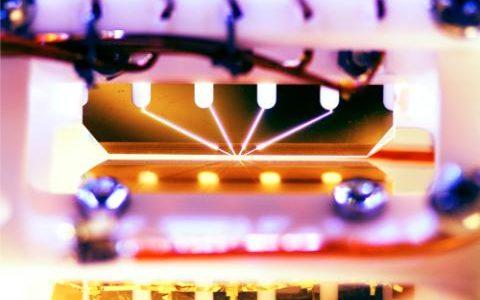Quantum computer programmed to solve simple algorithms for the first time
The breakthrough is a step towards a complete revolution in computing

Your support helps us to tell the story
From reproductive rights to climate change to Big Tech, The Independent is on the ground when the story is developing. Whether it's investigating the financials of Elon Musk's pro-Trump PAC or producing our latest documentary, 'The A Word', which shines a light on the American women fighting for reproductive rights, we know how important it is to parse out the facts from the messaging.
At such a critical moment in US history, we need reporters on the ground. Your donation allows us to keep sending journalists to speak to both sides of the story.
The Independent is trusted by Americans across the entire political spectrum. And unlike many other quality news outlets, we choose not to lock Americans out of our reporting and analysis with paywalls. We believe quality journalism should be available to everyone, paid for by those who can afford it.
Your support makes all the difference.Scientists are on their way to what might be the biggest revolution in computing this century.
They have built the first fully reprogrammable quantum computer and used it for the kinds of calculations that could allow the technology to overthrow existing understanding of computing.
Quantum computers use quits, rather than binary bits, which means that things can be in not just two states but a range of them. Scientists hope that by harnessing that power they can make computers that are far, far faster than existing ones – and use them to solve some of the biggest problems for mankind.
The new study is the first to show that such computers can be programmed and reprogrammed, and used to solve simple algorithms.
At the centre of the new device are five electrically charged atoms, or ions. They are trapped in a magnetic field and made to vibrate by laser beams that are precisely targeted on them.
Those beams can be used to manipulate the ions, exploiting the fact that they are able to be in more than one state at the same time – the essence of quantum computing. As such, the scientist could use that manipulation in ways that would be impossible for normal computers.
In testing, the computers were able to do a calculation in just one step, which in a normal computer would have taken several. Another test saw it complete a mathematical operation that would let it break through the kinds of highly secure encryption that is normally thought to be impossible.
The scientists say that the work done could be scaled up beyond the five “qubits” that it consists of now. They refer to the system as a “module”, since it can be reprogrammed and attached to other quantum computers, allowing it to be used flexibly.
US quantum physicist Professor Christopher Monrow, who led the University of Maryland team, said: "Very few people know what their iPhone is actually doing at the physical level.
"Our experiment brings high-quality quantum bits up to a higher level of functionality by allowing them to be programmed and reconfigured in software."
If that works it could challenge the most fundamental thinking in computing. Until now, all computers have worked by understanding information in binary on or off states – but quantum computers can understand a combination of off and on, at the same time.
They do so by harnessing the strange rules of quantum mechanics, where particles exist in a world of possibilities rather than fixed realities. Those particles, if they exist inside the computer, wouldn’t be in one state or the other but in simultaneous states called “superpositions”, which they stay in until they are actually observed.
If scientists are able to use those inside working and scaled up computers, they could be put to some of the most perplexing tasks in the world, which have traditionally been too big or complicated for conventional computers to solve.
The research is reported in the latest issue of the journal Nature.
Join our commenting forum
Join thought-provoking conversations, follow other Independent readers and see their replies
Comments